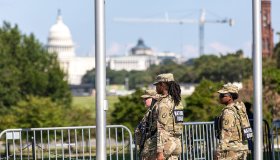
Source: abalcazar / Getty
A 2025 WalletHub study of 182 U.S. cities placed Washington, D.C. at No. 34 on the nationwide stress index, with an overall score of 47.99 on a 100‑point scale (where higher equals more stress). The study evaluated urban stress using 39 metrics across four categories: work, financial, family, and health & safety.
In work stress, D.C. ranked exceptionally high at No. 5, reflecting long average work hours, substantial commute times, and a strong culture of unused vacation time, a trend consistent with previous rankings naming D.C. among the nation’s hardest-working cities. Meanwhile, in financial stress, the city ranked much lower, No. 130, indicating relatively less pressure in that category. Family stress placed the city around No. 28, and it ranked 65th in health & safety stress, suggesting moderate performance across those dimensions.
Despite being the nation’s capital, with high educational achievement, cultural institutions, and abundant green space, D.C. residents face significant stress tied to work intensity and the pressures of living in a politically driven, high-performance environment. The city’s workforce culture, marked by long hours and high expectations, continues to drive elevated stress levels, even as other challenges like poverty and crime are comparatively less severe than in more distressed cities.
By contrast, cities topping the stress rankings, such as Detroit, Cleveland, and Baltimore, face compounded crises in unemployment, crime, divorce, and economic instability.
In summary, Washington, D.C. lands in the upper third of America’s most stressed cities, driven primarily by intense work-related pressures. While it may not face the same breadth of issues as some of the nation’s most burdened urban areas, the unique demands of life in the capital still take a clear toll on residents’ well-being.
Washington, D.C. Among America’s Most Stressed Cities in 2025 was originally published on wolbbaltimore.com
1. Detroit, MI
Washington, D.C. Among America’s Most Stressed Cities in 2025 was originally published on wolbbaltimore.com
2. Cleveland, OH
Washington, D.C. Among America’s Most Stressed Cities in 2025 was originally published on wolbbaltimore.com
3. Baltimore, MD
Washington, D.C. Among America’s Most Stressed Cities in 2025 was originally published on wolbbaltimore.com
4. Gulfport, MS
Washington, D.C. Among America’s Most Stressed Cities in 2025 was originally published on wolbbaltimore.com
5. Memphis, TN
Washington, D.C. Among America’s Most Stressed Cities in 2025 was originally published on wolbbaltimore.com
6. Shreveport, LA
Washington, D.C. Among America’s Most Stressed Cities in 2025 was originally published on wolbbaltimore.com
7. Philadelphia, PA
Washington, D.C. Among America’s Most Stressed Cities in 2025 was originally published on wolbbaltimore.com
8. Toledo, OH
Washington, D.C. Among America’s Most Stressed Cities in 2025 was originally published on wolbbaltimore.com
9. Birmingham, AL
Washington, D.C. Among America’s Most Stressed Cities in 2025 was originally published on wolbbaltimore.com
10. Jackson, MS
Washington, D.C. Among America’s Most Stressed Cities in 2025 was originally published on wolbbaltimore.com
11. Akron, OH
Washington, D.C. Among America’s Most Stressed Cities in 2025 was originally published on wolbbaltimore.com
12. Baton Rouge, LA
Washington, D.C. Among America’s Most Stressed Cities in 2025 was originally published on wolbbaltimore.com
13. Montgomery, AL
Washington, D.C. Among America’s Most Stressed Cities in 2025 was originally published on wolbbaltimore.com
14. St. Louis, MO
Washington, D.C. Among America’s Most Stressed Cities in 2025 was originally published on wolbbaltimore.com
15. Wilmington, DE
Washington, D.C. Among America’s Most Stressed Cities in 2025 was originally published on wolbbaltimore.com
16. Houston, TX
Washington, D.C. Among America’s Most Stressed Cities in 2025 was originally published on wolbbaltimore.com
17. Indianapolis, IN
Washington, D.C. Among America’s Most Stressed Cities in 2025 was originally published on wolbbaltimore.com
18. San Antonio, TX
Washington, D.C. Among America’s Most Stressed Cities in 2025 was originally published on wolbbaltimore.com
19. Milwaukee, WI
Washington, D.C. Among America’s Most Stressed Cities in 2025 was originally published on wolbbaltimore.com
20. New Orleans, LA
Washington, D.C. Among America’s Most Stressed Cities in 2025 was originally published on wolbbaltimore.com
21. Cincinnati, OH
Washington, D.C. Among America’s Most Stressed Cities in 2025 was originally published on wolbbaltimore.com
22. Newark, NJ
Washington, D.C. Among America’s Most Stressed Cities in 2025 was originally published on wolbbaltimore.com
23. Mobile, AL
Washington, D.C. Among America’s Most Stressed Cities in 2025 was originally published on wolbbaltimore.com
24. North Las Vegas, NV
Washington, D.C. Among America’s Most Stressed Cities in 2025 was originally published on wolbbaltimore.com
25. Augusta, GA
Washington, D.C. Among America’s Most Stressed Cities in 2025 was originally published on wolbbaltimore.com
26. Fayetteville, NC
Washington, D.C. Among America’s Most Stressed Cities in 2025 was originally published on wolbbaltimore.com
27. Las Vegas, NV
Washington, D.C. Among America’s Most Stressed Cities in 2025 was originally published on wolbbaltimore.com
28. Louisville, KY
Washington, D.C. Among America’s Most Stressed Cities in 2025 was originally published on wolbbaltimore.com
29. San Bernardino, CA
Washington, D.C. Among America’s Most Stressed Cities in 2025 was originally published on wolbbaltimore.com
30. Columbus, GA
Washington, D.C. Among America’s Most Stressed Cities in 2025 was originally published on wolbbaltimore.com
31. Dallas, TX
Washington, D.C. Among America’s Most Stressed Cities in 2025 was originally published on wolbbaltimore.com
32. Fort Smith, AR
Washington, D.C. Among America’s Most Stressed Cities in 2025 was originally published on wolbbaltimore.com
33. Modesto, CA
Washington, D.C. Among America’s Most Stressed Cities in 2025 was originally published on wolbbaltimore.com
34. Washington, DC
Washington, D.C. Among America’s Most Stressed Cities in 2025 was originally published on wolbbaltimore.com
35. Chicago, IL
Washington, D.C. Among America’s Most Stressed Cities in 2025 was originally published on wolbbaltimore.com






